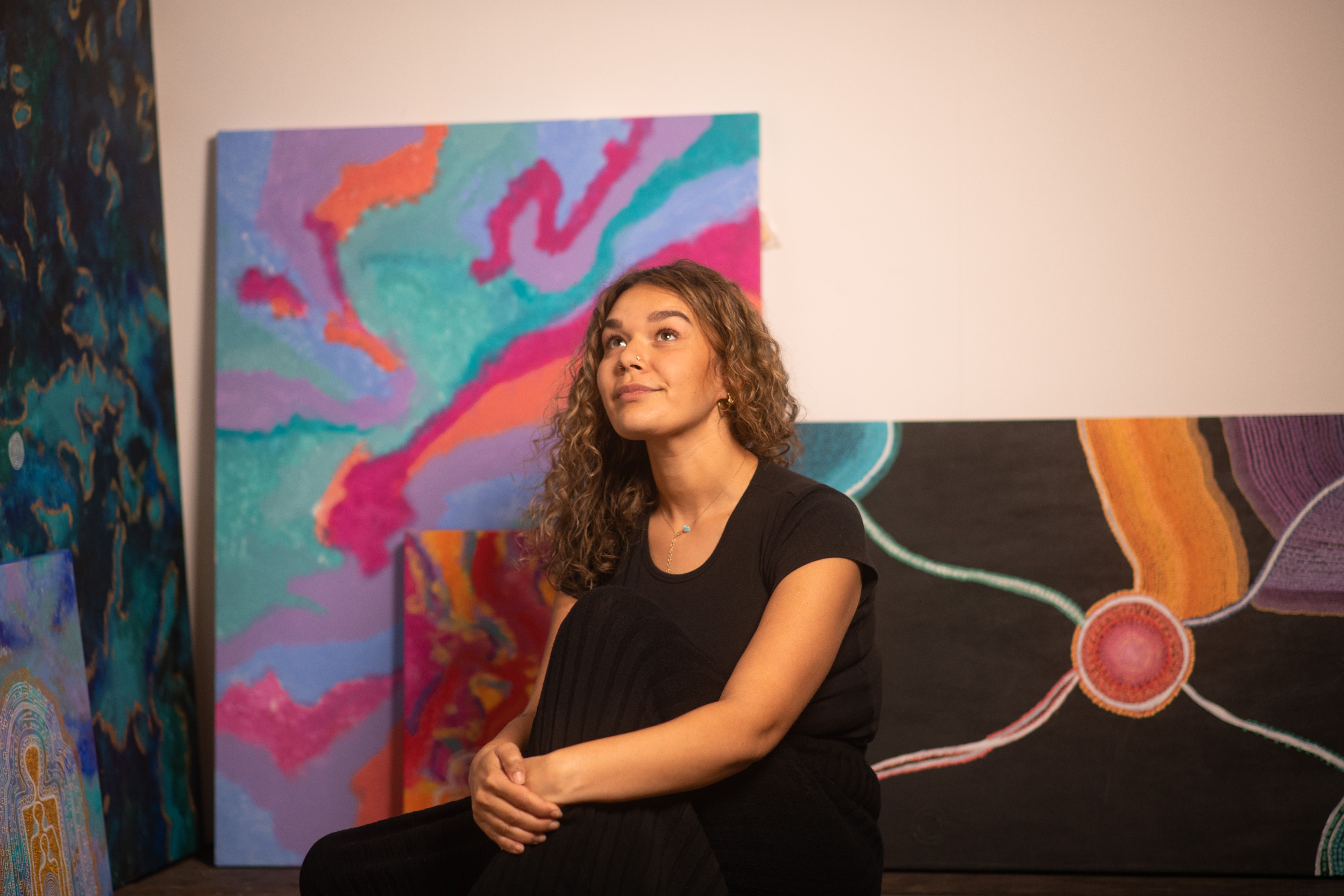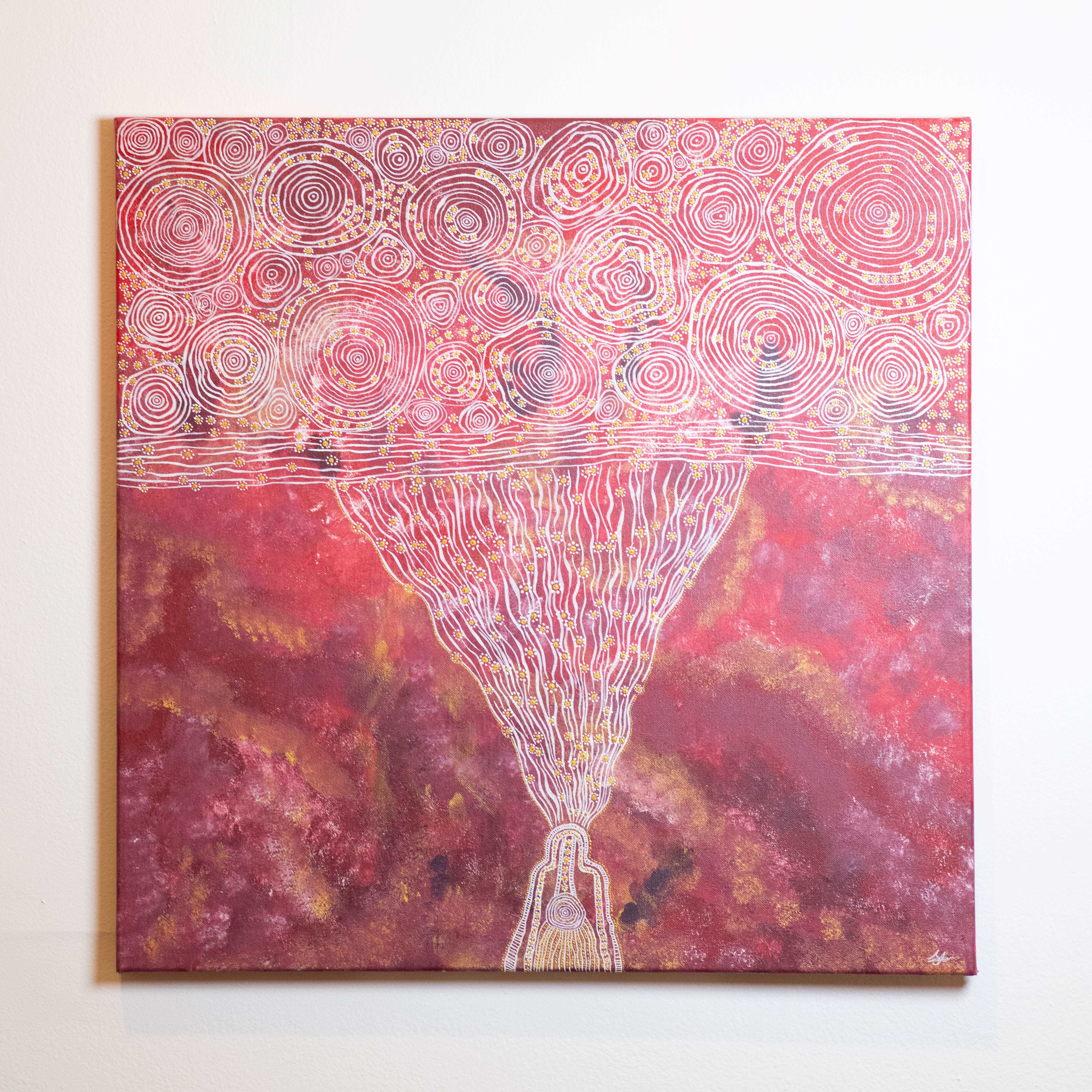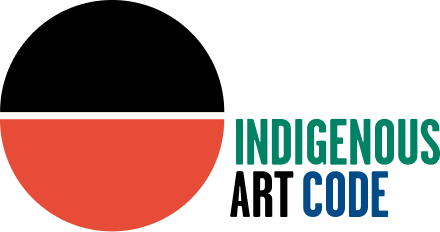Savannah Travia-Dann is a Nyul Nyul woman, with connections to Nyikina, Mangala, Bardi, Kija, Jaru, Bunuba, and Walmatjarri language groups throughout the Kimberley, through her paternal Grandmother’s lineage.
What does fair mean to you? Interview with artist Savannah Travia-Dann

Based in Boorloo (Perth, Western Australia), Savannah has been practising professionally as an artist since 2020, and since 2022 has worked for Indigenous Art Code (IartC) as Artist Engagement Officer. A painter specialising in works on canvas as well as murals, Savannah shares her experiences with readers in the hopes of encouraging others to “keep at it” and be informed as to their rights.
As an emerging artist, Savannah’s first experience in the “market” was on a commission basis – a potentially fraught and exposed foray for any emerging artist.
“Through the commissioning process, I’ve had buyers attempt to dictate my creative control by asking me to paint using certain colour schemes and requesting my works to look similar to other works I’ve created”, tells Savannah.
“Another instance occurred when someone who had commissioned an artwork of mine refused for me to use the digital images taken of the commission to be used for prints. [They] believed the artwork and copyright belonged to them. I’ve also had organisations try to lower my prices telling me that they wouldn’t sell if the price was too high”.
Savannah says that once she began working for IartC, she began to learn a great deal, not just about the ecology of the Indigenous art market and sector, but of her rights as an artist as well. Her work with IartC helped to introduce her to resources such as Arts Law and Copyright Agency. Savannah highly recommends all artists become familiar with these organisations and reach out to them for advice saying: “Education in this space is the key.” She says that if she hadn’t been supported by IartC, she might well have lost her confidence and stopped creating altogether. “I also encourage artists to utilise the free resources of NAVA’s rates guidelines, to ensure you’re asking for a fair price and not underselling yourself”, says Savannah.
When asked if she feels things are changing for the better, Savannah certainly thinks so. She says many artists know their rights more and that buyers are learning to ask the right questions when purchasing artworks from a code signatory or art gallery. She also says that, even since 2020, Savannah feels the awareness of copyright and how it’s retained by the artists even in circumstances of a sale, is increasing.
When asked what she feels is one of the biggest changes needed to further protect First Nations artists, she says that Indigenous Cultural & Intellectual Property (ICIP) laws are a crucial next step.
“ICIP rights matter to us as Cultural people, as it’s a way of honouring our old people, our stories, our knowledge banks, our Elders and a way for us to be accountable culturally – whether law be in place or not. It is the thread used to weave and guide our practice. Without this, our art has no liyarn (spirit)”.

Savannah also says that legally-recognised ICIP frameworks will be crucial to preserving Cultural and Lore-based techniques, visual and aesthetic language (iconography) from digital and overseas Fake Art producers, but also by other artists who may be struggling to find their unique ‘style’ as First Nations’ artists while navigating what the market deems as recognisable Indigenous art.
“We need to actively decolonise this space, as people may also feel shame about having recently discovered their heritage. This needs to be met with empathy but also education, reminding people that they are who they are regardless of the ‘style’ of art they choose to create. It doesn’t need to replicate what a “traditional artwork” is (e.g. dot painting), it can be your own expression of who you are without the use of sacred iconographies and symbols.”
“Ways in which this can be acknowledged and respectfully challenged is by allowing these conversations to be heart-led, engaging with empathy and placing ourselves in the shoes of the other person. Education in this area is also imperative, informing people of where styles come from. There also needs to be room for accountability, as that in itself is a cultural aspect of who we are. As young people, if we created a work that wasn’t connected to us or our family groups, an Elder would pull us up and let us know that we’re not honouring our mob by using those designs”, tells Savannah.
With the Office for the Arts venturing into the Indigenous Cultural & Intellectual Property legal protections, this is a space to watch for all participating in the Indigenous art sector. Indigenous Art Code is here to help artists and code signatories and all those interested in learning more about what rights and supports are available today.
_________________________
Indigenous Art Code asks Code Signatories (Code Signatories) to work fairly and transparently with artists, and the Indigenous Art Code of Conduct (the Code) sets out guidelines for Code Signatories to do this.
But from the artist’s perspective, what is fair?
Following conversations with Waanji, Teppathiggi and Tjungundji artist, writer, activist and deep thinker, Jack Wilkie-Jans, Indigenous Art Code commissioned him to write something about the concept of ‘fair’ from the artist’s perspective. In this series of interviews, Jack speaks with a diverse group of First Nations artists and cultural practitioners from across the country to better understand what fair means to them when they are creating art that is to be sold or licensed.

Jack Wilkie-Jans (Waanji, Teppathiggi and Tjungundji man of British, Vanuatuan and Danish heritage) is an established arts writer, artist, arts worker, and Aboriginal affairs advocate from Cape York Peninsula, based in Cairns/Gimuy, Queensland. After 12 years working across the contemporary Indigenous visual arts sector at all levels of project management, domestically and internationally, in 2023 Jack launched his own consultancy practice: JWJ Consultancy. Professionally, Jack specialises in arts writing & review; policy guidance; governance and operational best Cultural practice; artist representation; regional economic development; and land management.
A Tribal Great-Grandson of Dr Thancoupie/Thanakupi Gloria Fletcher James AO, Jack is an Alumni of the National Gallery Leadership Program (2011). As an artist (painting, film and photography) his focus is on post-colonial narratives and non-Culturally specific artistic abstraction and exploration.

